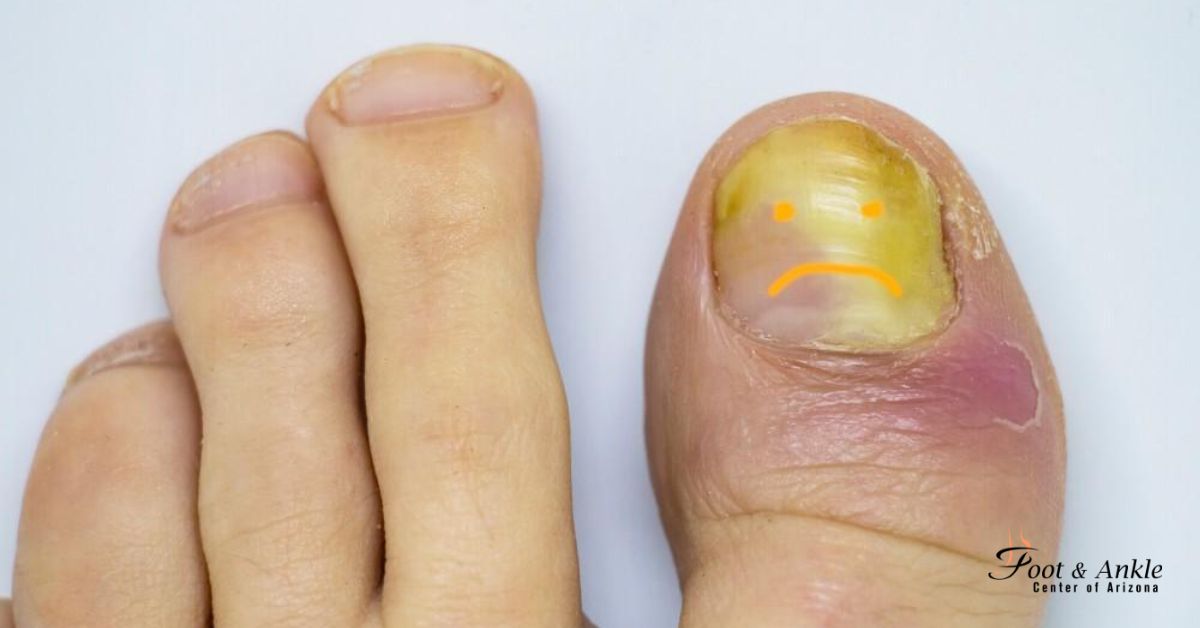At the Foot and Ankle Center of Arizona, led using Dr. Kris A. DiNucci, DPM, FACFAS, we often come across sufferers involved in approximate modifications within the color and texture of their toenails. One not-unusual question we listen to is, “Why is my toenail yellow?” Yellow toenails can be an alarming and unpleasant problem, prompting many to seek clinical advice. In this complete article, we are able to delve into the diverse reasons for yellow toenails, discover preventive measures, and discuss effective treatment alternatives.
Causes of Yellow Toenails
Fungal Infections
One of the most everyday motives for yellow toenails is fungal contamination, additionally called onychomycosis. This situation occurs whilst fungi, along with dermatophytes, invade the nail bed and plate, main to discoloration, thickening, and crumbling of the nail. Fungal infections thrive in warm, moist environments, making toenails mainly susceptible, specifically for folks who often wear closed-toe shoes or walk barefoot in communal areas like locker rooms and swimming swimming pools.
Psoriasis
Psoriasis is a chronic pores and skin situation that also can affect the nails. When psoriasis impacts the toenails, it can cause quite a number of symptoms, including yellowing, pitting, and thickening. Nail psoriasis is regularly related to other pores and skin manifestations, which include crimson, and scaly patches at the frame.
Diabetes
Individuals with diabetes are at a higher risk of growing diverse foot and nail troubles, along with yellow toenails. Diabetes can lead to bad movement and a weakened immune gadget, making it less difficult for infections to take keep. Additionally, diabetic neuropathy can cause reduced sensation inside the feet, leading to ignored injuries that become infected.
Aging
As we age, our nails undergo changes that can result in discoloration. Older adults often experience yellowing of the nails due to a slower rate of nail growth and reduced blood flow to the nail bed. While this is generally a harmless part of aging, it can sometimes be exacerbated by other underlying health conditions.
Nail Polish
Frequent use of nail polish, especially darker shades, can lead to yellow toenails. This discoloration occurs when pigments from the polish seep into the nail, staining it over time. Not allowing the nails to breathe between polish applications can worsen this issue.
Smoking
Smoking is another common cause of yellow toenails. The tar and nicotine in cigarettes can stain the nails, leading to a yellowish hue. Additionally, smoking can impair blood flow, contributing to poor nail health.
Other Medical Conditions
Several other medical conditions can cause yellow toenails. These include lymphedema (swelling due to lymphatic system issues), jaundice (a condition that causes yellowing of the skin and eyes due to liver problems), and respiratory conditions like chronic bronchitis.
Preventive Measures
Preventing yellow toenails involves a combination of good hygiene practices, lifestyle adjustments, and regular foot care. Here are some effective preventive measures:
Maintain Proper Foot Hygiene
Regularly washing and punctiliously drying your feet, mainly between the toes, can help prevent fungal infections. It’s also crucial to keep your toenails trimmed and easy.
Wear Appropriate Footwear
Choose breathable, well-fitted shoes that allow air circulation and reduce moisture build-up. Avoid sharing shoes and always wear shower shoes in communal areas to reduce the risk of fungal infections.
Limit Nail Polish Use
Give your toenails a break from polish occasionally to prevent staining. When you do use nail polish, opt for a clear base coat to create a barrier between your nails and the colored polish.
Avoid Smoking
Quitting smoking can improve your overall health and prevent the yellowing of your nails. Smoking cessation can also enhance blood flow, promoting healthier nails.
Manage Underlying Health Conditions
If you have conditions like diabetes or psoriasis, work closely with your healthcare provider to manage them effectively. Proper management can prevent complications, including nail discoloration.
Treatment Options
Topical Antifungal Treatments
For fungal infections, over-the-counter or prescription antifungal creams, gels, and nail lacquers can be effective. These treatments typically need to be applied daily for several months to eradicate the infection.
Oral Antifungal Medications
In more severe cases of fungal infections, oral antifungal medications may be necessary. These medications, such as terbinafine or itraconazole, are usually taken for a few weeks to a few months and require monitoring for potential side effects.
Laser Therapy
Laser treatment is a newer option for treating fungal nail infections. The laser targets the fungi directly, killing them without damaging the surrounding nail tissue. Multiple sessions may be needed, and the effectiveness can vary.
Topical Steroids for Psoriasis
If psoriasis is the cause of yellow toenails, topical steroids or other psoriasis-specific treatments can help manage the symptoms. These medications reduce inflammation and slow down the overproduction of skin cells.
Home Remedies
Some people locate alleviation from yellow toenails through home remedies, which include making use of tea tree oil, vinegar soaks, or Vicks VapoRub. While these methods can be helpful for slight instances, they’re typically less powerful than medical remedies and have to be used with caution.
Nail Removal
In extreme cases where the nail is severely damaged or infected, partial or complete removal of the nail may be necessary. This procedure is typically followed by the application of antifungal treatments to the nail bed to prevent recurrence.
When to Seek Medical Attention
While yellow toenails can often be managed with preventive measures and over-the-counter treatments, certain situations warrant professional medical attention:
- Persistent Discoloration: If the yellowing persists despite home treatments, it could indicate a more serious underlying condition.
- Severe Pain or Swelling: Pain, swelling, or pus around the nail may suggest an infection that requires medical intervention.
- Spread to Other Nails: If the discoloration spreads to other nails or if multiple nails are affected, a comprehensive evaluation by a healthcare provider is advisable.
- Associated Health Conditions: Individuals with diabetes, psoriasis, or other chronic conditions should seek medical advice if they notice any changes in their toenails.
Conclusion
Yellow toenails may be due to a range of things, ranging from fungal infections and psoriasis to way of life selections like smoking and frequent nail polish use. At the Foot and Ankle Center of Arizona, Dr. Kris A. DiNucci and our crew are devoted to helping you maintain the greatest foot health. By informing the causes of yellow toenails and imposing preventive measures, you can maintain your toenails healthy and keep away from capability headaches. If you revel in persistent or intense symptoms, do not hesitate to are seeking professional scientific advice to ensure proper analysis and remedy.
Taking proactive steps to care for your feet and nails can make a massive difference in your average fitness and well-being. Remember, wholesome feet are the muse of a wholesome life, so prioritize your foot care today.


